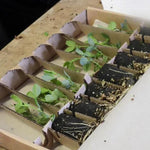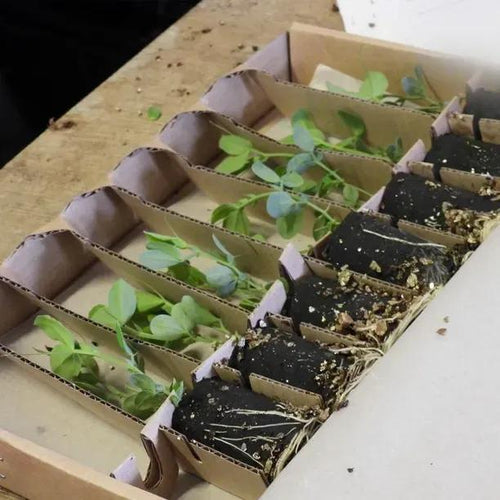'Mollie Rilstone' Sweet Pea Plants
Mollie Rilstone (Lathyrus odoratus) is many people's ideal Sweet pea variety - and with good reason. Its large, Spencer-type frilly blooms are a delicate shade of cream, set off perfectly by a dusky pink picotee edging and light veining. Mollie is the go-to variety for exhibitors who want a picotee bloom that doesn't fade too quickly as the flower opens and ages, making it perfect for showing. It's also very consistent for a picotee, which often vary in colouration. The lovely colour combination gives the flowers a real vintage appeal, perfect for a traditional and cottage garden setting. Add the lovely, typical sweet pea scent to its good looks, and it's no wonder she is so popular.
Browse our sweet pea range.
Our Sweet Peas are delivered in purpose-designed, recycled cardboard packaging, and are ready to be planted out when you get them.
We generally send them out between March and May, but we will email you with the likely delivery timescale once you have placed your order.
Features
- Colour: Cream, dusky pink picotee edging
- Stem: Long
- Height: 1.8m-2m
- Type: Spencer
- Scent: Strong and sweet
- Flowering: June-September
- Planting Months: March-June
- One of the more consistent picotee blooms
- A favourite of exhibitors
- Popular 'vintage' colouring ideal for cottage gardens
- Perfect for cutting
Garden Design Ideas
Whether you grow it on its own or mixed with other sweet pea varieties, she is sure to be a hit. Fragrant sweet peas are especially good planted near sitting areas where the perfume can be appreciated at leisure. The blooms won't get lost in large border displays like some single colour, darker varieties, but it's still wise to plant them within easy reach of a path, so you can deadhead regularly and easily to keep the plants flowering. Remember, the formation of sweet pea seed pods mean the plant has done its job of setting seed and doesn't need to produce more flowers. That's why the more you pick, the more flower buds the plant makes.
Imagine growing it in a traditional-style fragrant cottage border with deep pink roses, or the deep crimson Rosa de Rescht, underplanted with lavender and scented annuals like Nicotiana (tobacco plant). She is also suitable for growing in large pots but do remember sweet peas are hungry and thirsty plants, and they'll need regular watering and feeding with a high-potash fertiliser to encourage flower formation. Make sure the pot is big enough to support a growing frame securely - if it isn't, train the plants up a sunny wall covered with a pea or bean net or trellis. Tie into the supports if necessary, especially in windy areas - the plants can snap, especially if they've outgrown their canes or wigwam and are very top-heavy.

 Secure, One-Tap Checkout
Secure, One-Tap Checkout
 Hand Picked, Delivered to Your Door!
Hand Picked, Delivered to Your Door! 1 Year Bareroot Guarantee
1 Year Bareroot Guarantee






